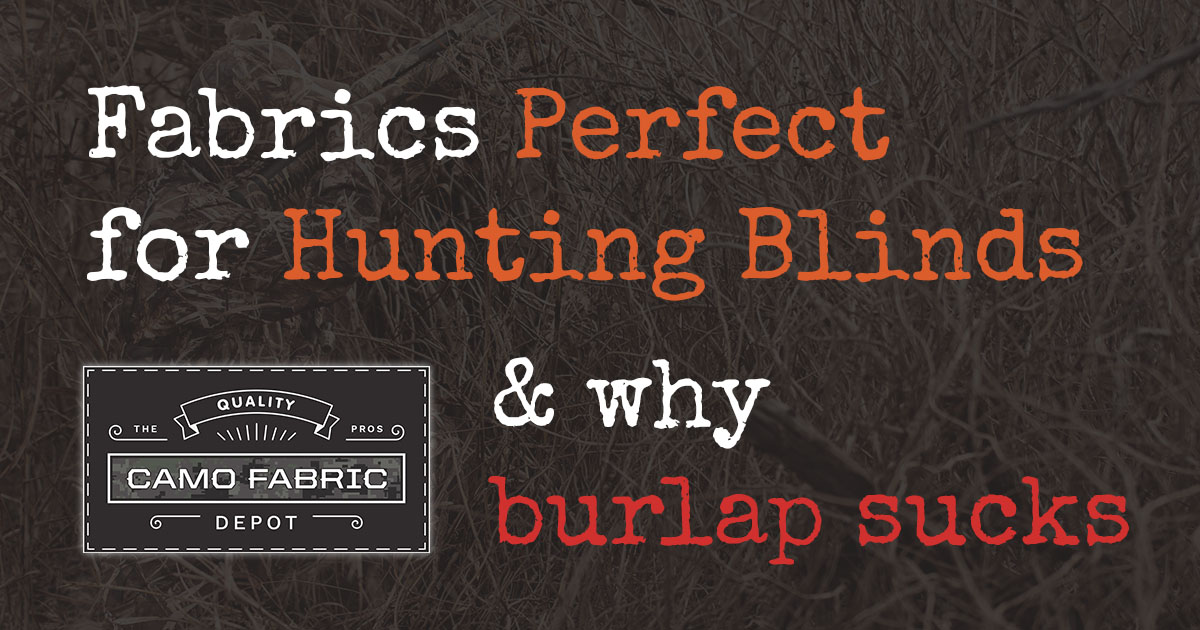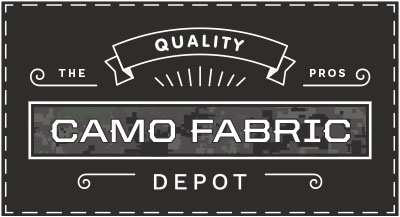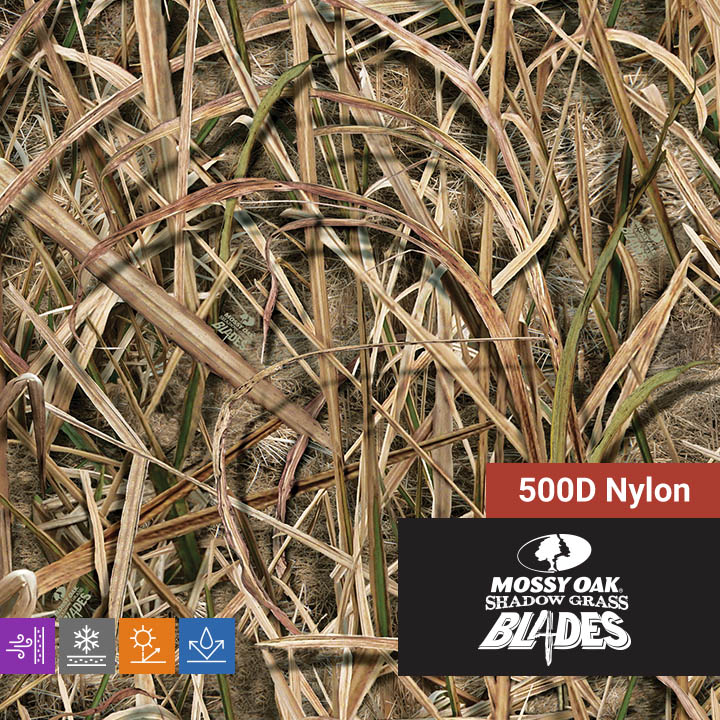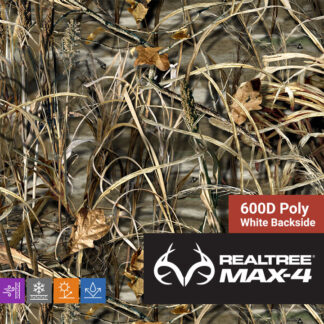
When you can’t find the right blind for your hunting needs you need to create your own. Depending on how sophisticated your blind design is you may only need quality fabric and a few stakes. A lot of people like to use burlap and that’s all well and good if you can deal with these burlap drawbacks. We recommend using 500D Cordura Nylon or 600D Poly Oxford. If you are in search of the perfect hunting blind fabric you have come to the right place.
Burlap is a Bad Choice for Hunting Blinds
- Burlap stinks
From the start burlap smells musty. After exposing the fabric to the outdoors the smell gets more pungent and produces mildew. - Burlap is hard to clean
You can’t just throw burlap into the washing machine and expect to get the same fabric back. Burlap thrown into a washing machine has the potential to distort severely. It can be cleaned and the odor might be able to be removed with “gentle” care. But as a hunter.. Who has time for that? - Burlap doesn’t print well
Burlap is a very coarse, organic fabric. With the rough, inconsistent texture getting a quality camo pattern print is next to impossible. When purchasing my favorite pattern on fabric I like to see vibrant colors that are consistent with the rest of my hunting gear. - Burlap deteriorates and decomposes
Since burlap is organic it will start to decompose and deteriorate once exposed to the elements. This will cause the fabric to stink, fall apart and lose print details - Burlap is not a waterproof or water resistant fabric
This is a no-brainer. Burlap is a loosely woven fabric which in no way can repel water.
If you are like me and have experienced any of these burlap shortcomings you will know that what I speak is true. Luckily there is a better, longer lasting hunting blind fabric available that is easy to clean and water resistant.
Recommended Fabrics for Hunting Blinds
500D Cordura Nylon
A durable fabric with high abrasion resistance, 500D Cordura Nylon is perfect for outdoor usage and hunting gear items. This fabric uses textured nylon 6,6 yarns for a rugged feel and comes with a 2 pass polyurethane coating making it water repellent. This fabric is perfect for hunting blinds and can also be used for gear bags, backpacks, seat covers and much more. Basically, if you want a fabric that will perform well, can be used and abused, then this is the fabric you want.
600D Poly Oxford
This is a more economical alternative to the 500D Cordura Nylon. This fabric has a smoother finish and is another fabric made for the great outdoors. It has a polyurethane coating and water repellent finish, making it weather-resistant and easy to clean. This fabric is a great hunting blind fabric and is also suitable for bags, backpacks, seat covers, gun cases and more.






Is it stronger than burlap I’m gonna use it to cover a boat on the marsh for duck hunting thanks which would b better for that use ? 500d nylon or 600 d poly
Yes. 500D or 600D are going to be a lot stronger than burlap. Here is a video of a guy building his duck blind with 500D. This will give you an idea of what type of fabric it is. https://youtu.be/lKJNSVaC0gQ?t=173 .. 500D and 600D are similar. 500D is a little stronger than the 600D.
It’s 60 inches wide right ?and I’ll need 6 yards to make it 18 foot ? Does it come white on outside edges I don’t want any white on it for ducks to see
All of the fabric we sell will come with a selvedge (approx. ½”) on either side, which is usually cut off during the manufacturing process. Sometimes this is printed over and sometimes it’s left white. This is really on a case-by-case & lot-by-lot basis, so it’s hard to guarantee you will not have an unprinted selvedge.
The easiest way to remedy is to fold the selvedge under (if sewing) or to cut it off. Because the goods have a PU coating on them, the remaining fabric will still hold together well and won’t unravel, even if you cut the selvedge off.
In my own experience, 500D nylon will more often have a printed selvedge than 600D poly. 600D poly usually has a white edge.
I am looking for something 6 ft tall an 100 ft long i’m building a fence,but can’t put in fence posts to rocky will hang from tree’s can’t use snow fence hole’s are to large people can look through them,hope you can help me out thank you
Hi Jack,
I”m not 100% sure what you are looking for, based on your email. Can you give me some more explanation?
Most of our fabric is 60″ (5ft) wide. The 100 ft of continuous length is not a problem. I carry a few fabrics that are 67″, but these are mostly cotton duck. If you are looking to build a fabric fence (curtain style is the best way to put this, I guess) then you want a 100% synthetic, like 500D Cordura nylon, 600D polyester (heavyweights) or 70D nylon ripstop (lightweight). All of these have a water repellent treatment and PU coating on the back.
Please advise if I am off base here. If I’m correct about your project, just type these descriptions into the search bar and it will give you a list of pattern options for each one.
Thanks and wishing you good luck on this!
Bryan
Can i get this price any cheaper? This is for one of my school projects .
Hi Alex,
I can offer you a 10% off coupon code. Just type in cfd10off and it will take it off your total.
Thanks for checking with us!
Bryan
I’m looking for a netting type fabric that has a camouflage print. Using as a ground blind that will interrupt outlines, but allow Hunter to see through. About 5 yards should do.
Hi Ted. We offer two types of meshes – bug mesh and concealment mesh. Bug mesh is very fine screening and very lightweight. The concealment mesh is a heavy mesh that stays in place. It has larger holes. Both would interrupt the shapes of the person inside and both offer vision from inside the blind (if you are close enough to the material). But, being mesh fabric, neither would completely conceal movement from inside. In a perfect world, it would be best to use a fabric that completely conceals you (https://cfd.studio2interactive.com/shop/600d-poly-shadowblock-mossy-oak-break-up-country-60/) and use the mesh for look out windows.
If you’d rather do the entire blind in mesh, I’d recommend the concealment mesh. The bug mesh is too light for this. We offer concealment mesh in a variety of patterns. Just type “concealment” in the search bar at the top.
Good luck!
What’s the big difference between 500D Cordura Nylon and 600D Poly Oxford? I used to build duck blind out of wood but I want something lighter and more portable. PVC pipes and a fabric seem the logical choice. The blind will stay outdoor for all the season and must be somewhat water proof. Does poly oxford could do the job?
Hi Marc. Thanks for checking in with us!
Yes, poly oxford could do the job and do it well. The Cordura is a stronger fabric and should be your choice if you expect to constantly tear down and rebuild your blind frequently or subject it to lots of abuse. But the poly oxford is strong enough to put up with most normal everyday wear. It’s the typical choice of fabric for backpacks and camping chairs, so it’s designed to stand up to wear and tear. The 500D Cordura does have one extra layer of PU coating, so it will add some to it’s heftiness and add to it’s water-resistant properties. Both fabrics are considered weather and water-resistant though.
One other point worth noting – the polyester is transfer printed and the nylon is pigment printed. The transfer print looks much sharper and crisper than pigment, but it does not do as well with UV fading. So, the colors in the polyester will fade sooner than the nylon. It’s an accepted trait in the camouflage world and the trade off for how sharp and detailed the image quality turns out.
Hope this helps with your questions! Let me know if I can answer anything else. Bryan
Are these fabrics printed only on one side? If so, what color is the backside?
Hi Eric – yes, they are all printed on one side. The backside coloration depends on what type of fabric and also on what pattern. They will all be some variation of very light gray, beige or white. The only exception is we provide one 600D polyester fabric (Mossy Oak Country) with a black PU backing.
Some fabrics (like the twills, jersey, nylons, fleece, etc) will also have a little bleed-thru. The print shows up some on the back side of the fabric. This is typically very light though – with the exception of the fleece.
Hope this helps! If you have a question on a specific fabric, let me know.
Tks!
[…] Burlap is awful in comparison. These fabrics are perfect for hunting blinds. […]
Are any of these materials impermeable to light? I’m trying to make a compact blind that will not allow light to pass through, so that I’m not silhouetted when the sun is behind me. When I have searched for black-out fabric for blinds, all that I have found are home decoration websites!
Not what I’m looking for! I have hunting blinds with this type of fabric. They usually have a black coating on the inside.
Thank you for your time.
Hi Kevin,
Yes, we do make fabric like this. We refer to the black back coating as “Shadowblock” and we offer it in polyester hunting blind fabric in Mossy Oak Country and Break-Up. Here is a link to the product page for these two items. https://cfd.studio2interactive.com/?s=shadowblock&post_type=product
Which direction do the prints run? Is it 60″ from top to bottom, or does the print run down the length of the fabric. I am building a duck blind and need to know how to order the fabric. I don’t want sideways grass.
Hi – that’s an important question and thanks for asking. The fabric is 60″ wide. The print runs the LENGTH of the fabric. Meaning, to make a blind without the grass (or trees, limbs, etc) running sideways, you would have to cut panels to size and affix them.
The grass patterns are a little more uni-directional than the big game camo prints and I have seen people use the 60″ width as the height and “wrap” it around lengthwise. It looks ok but the best way to do it is to cut panels. Hope this helps!
So to make sure I’m understanding correctly. Would you say the grass blades run parallel to the 60 inch?
The easiest way to say it is the grass blades run the length of the fabric. Meaning if you rolled out 100 yds of this fabric, the grass would just keep running on and on the entire length. Hope this helps!
Would the 500D cordura nylon be good to use to recover a hunting chair? The style of the chair is similar to a captain’s chair where the back just slips over 2 posts and the bottom is hanging free. My concern would be if the bottom would hold weight well.
Yes, this would be an excellent choice for a hunting chair. 500D Cordura is strong fabric and would hold up well for this. tks!
I am building a 6×6 wooden box blind and want to wrap the exterior instead of painting it. Which material would you suggest for year round exposure? Thank you.
Hi Chris. 500D Cordura nylon has been far and away our most popular fabric for blinds. It is durable, waterproof, resists rot and mold and does a decent job against UV exposure. The 600D polyester is also used, but will not do as well against UV exposure. Also, if ordering the 600D, the fabric will be white on the back (unless you select one specifically with the shadowblock backing). Sounds like in your situation this will not be an issue, since I believe the back of the fabric will be directly against the wood. But, just FYI.
Lastly, please consider that the patterns run the length of the fabric when deciding how many yards you will need. Meaning you cannot simply take the fabric and wrap it all the way around the blind or the details (trunks and limbs) will run sideways. Best to cut panels and reorient them vertically.
So to make sure I’m understanding correctly. Would you say the grass blades run parallel to the 60 inch?
Hello this fabric is exactly what I’m looking for though I want straps sewn on it so I can add foliage to the blind I’m making do you have that material or know where to find it?
Hi Connor!
Sorry, not sure where you can find material to make the stubble straps. Good luck in searching for them, though!
We have a wooden photo blind “shack” with openings covered by shirred curtains that we can pull apart to stick our cameras through. Would either of these fabrics be better for shirring? Would the sturdier Cordura nylon be harder to gather on the curtain rods? Also is there a type of thread you would recommend to hold up better outdoors?
Hi Marry Ann! Sorry, but neither of these fabrics would gather well enough to make shirred curtains out of, in my opinion. You would need to use something like the CWC twill or lighter. The poly tricot, CWC duck, cotton sheeting and a few others would work well too. I only have these fabrics in limited patterns, though. And none of these are weather-resistant. If it needs to be water-resistant, the only fabric I can see working here is the 70D nylon ripstop with PU coating.
Is the nylon fabric printed on both sides? If not what does the wrong side of fabric look like?
The Cordura nylon fabric is only printed on one side. However, there is a significant amount of print “bleed through” that creates an image of the camo on the back side. It is slightly ghosted compared to the face side, but is still very prominent.
I’m looking for the best fabric that will hold up outdoors. It is for a duck blind but will be in the sun, rain, snow and ice 365 days a year. Thanks
The best fabric we carry for hunting blinds is the 500D Cordura nylon. It is rugged and tough and weather-resistant. It’s our number one seller for blinds. We do carry a heavier version – 1000D Cordura. But, it’s only available in select patterns. Please check all of this out at http://www.camofabricdepot.com
Looking at covering a metal deer blind that I am mounting in my Polaris ranger. What would be the best one to withstand the weather?
Hey Jake,
The 500D Cordura nylon would be the most durable fabric, as well as the most weather-resistant and would fade the least from sunlight. If you need a more economical fabric, the 600D poly is pretty durable and water resistant itself and would work. However, the print on this fabric will react with the sunlight more and will tend to flare towards the red, giving it a light red/pinkish cast over time. Hope this helps your decision!
I need 16 ft long and 46 inches wide. How many sq feet is that. Thx.
Hi Rodney,
This works out to approx 62 sq ft. However, the fabric will be approx 60″ wide and is ordered by the yard. So, in order to get 16 continuous feet, you will need to order 6 yards of fabric. This will give you 18ft long and 60″ wide and from there you can cut this down to the size you need.
is this product one-way see through?
Neither the 600D poly nor the 500D nylon are really see through. See through blinds typically used a camo-printed mesh fabric. We do sell bug mesh in Mossy Oak Break-Up pattern, if you want to try that.
https://cfd.studio2interactive.com/shop/bug-mesh-mossy-oak-break-up-60/